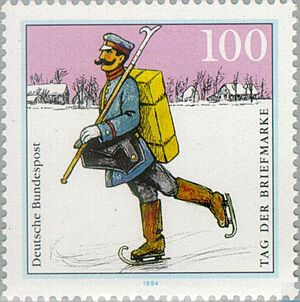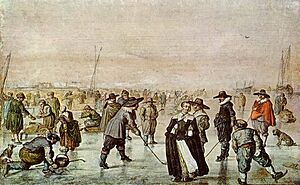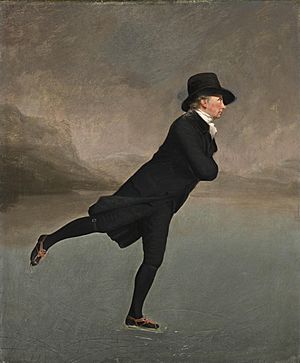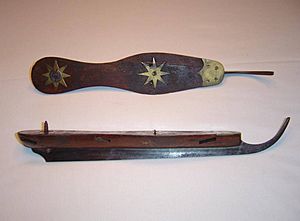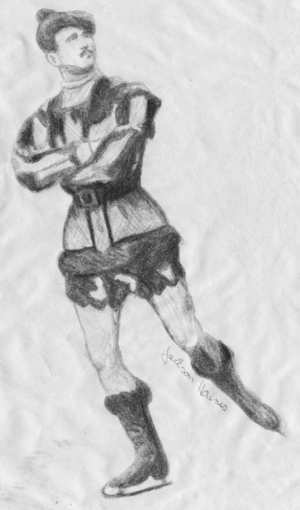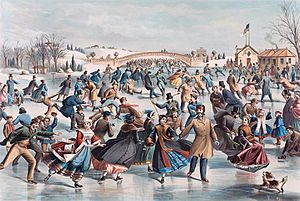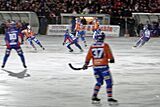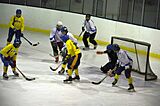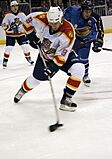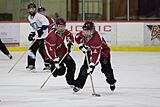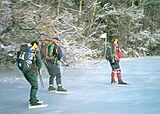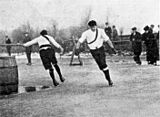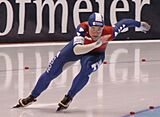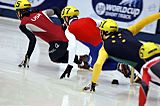Ice skating facts for kids
Ice skating is when a person glides across an ice surface using special metal-bladed ice skates. People ice skate for many reasons. Some do it for fun or exercise. Others compete in sports, and some even use skates to travel short distances. You can skate on naturally frozen places like ponds and lakes. You can also skate on human-made ice surfaces, both indoors and outdoors.
Natural ice surfaces are great for many winter sports. They are also used by skaters who want to go long distances, like in tour skating and speed skating. Human-made ice surfaces include ice rinks, ice hockey rinks, and special tracks for sports like ice cross downhill.
Since the 1800s, many official sports have developed around ice skating. Ice hockey, bandy, rinkball, and ringette are team sports. They use a puck, a ball, or a rubber ring. Synchronized skating is a unique artistic team sport that comes from figure skating. Other sports for individuals include figure skating, ice cross downhill, speed skating, and barrel jumping.
Contents
History of Ice Skating
Early Days of Skating
Experts believe that ice skating first started in southern Finland over 4,000 years ago. People used it to save energy when traveling in winter. Real skating began when people used steel blades with sharp edges. These blades cut into the ice instead of just sliding on top. The Dutch added edges to ice skates in the 13th or 14th century. These early skates were made of steel.
The basic design of modern ice skates is still similar today. However, the way they attach to boots and the shape of the blades have changed a lot. In the Netherlands, ice skating was popular with everyone, not just rich people. Many paintings from the Dutch Golden Age show this.
Ice skating was also practiced in China during the Song dynasty. It became very popular with the ruling family of the Qing dynasty. Very old ice skates, made from animal bones, were found in northwest China. They are about 3,500 years old. These ancient skates are similar to bone skates found in Europe. This suggests that people in China and Europe were connected even in the Bronze Age.
How Skating Became Popular
In England, people used butcher's bones as skates as early as the 1100s. Metal skates likely came to England around 1660. This was when the king and court returned from living in the Netherlands. In London, St James's Park was a main skating spot. Famous diarists Samuel Pepys and John Evelyn saw skating there in 1662. Pepys called it "a very pretty art."
The first organized skating club was the Edinburgh Skating Club in Scotland. It was formed in the 1740s. Some even say it started as early as 1642. The club was mentioned in the Encyclopædia Britannica in 1783. It said that Scotland had "more instances of elegant skaters than perhaps any country whatever."

To join the Edinburgh club, skaters had to pass a test. They had to skate a full circle on each foot (like a figure eight). Then they had to jump over one, two, and then three hats placed on the ice. This shows that they were practicing an early form of figure skating.
In Europe, ice skating was mostly for rich people. Emperor Rudolf II of the Holy Roman Empire loved ice skating so much that he held a big ice carnival. King Louis XVI of France brought ice skating to Paris. Many royal and upper-class people enjoyed it, including Madame de Pompadour and Napoleon I.
The next skating club was founded in London in 1830. By the mid-1800s, ice skating was a popular hobby for many British people. Queen Victoria even met her future husband, Prince Albert, during ice skating trips.
People tried to build artificial ice rinks in the 1840s. Since they couldn't keep natural ice frozen, they used a mix of hog's lard and salts. One of these early rinks was called the 'Glaciarium'. It was described as "extremely convenient" for skating.
Skating Becomes a Sport
Skating became popular for fun, travel, and as a sport in The Fens in England. Racing was common among workers, especially farmers. We don't know exactly when the first races happened, but by the early 1800s, racing was well-known. Results were even reported in newspapers. Skating as a sport also grew on the lakes of Scotland and canals of the Netherlands. In the 1200s and 1300s, wood replaced bone in skate blades. In 1572, the first iron skates were made.
When the waters froze, skating races were held in towns and villages across the Fens. People competed for money, clothes, or food. Winners of local races could then compete in bigger championship matches. Skaters from all over the Fens would race for cash prizes in front of thousands of people. These championships were "last man standing" contests. Skaters raced in pairs, and the winner moved to the next round. A race course was usually 660 yards long. For a one-and-a-half-mile race, skaters would go around the course twice, making three turns around barrels.
In the Fens, skates were called pattens, fen runners, or Whittlesey runners. The part that held the foot was made of beechwood. A screw at the back went into the boot's heel, and three small spikes at the front kept the skate steady. Leather straps fastened the skate to the foot. The metal blades were a bit higher at the back. In the 1890s, fen skaters started using skates like those from Norway.
On February 1, 1879, professional ice skaters from Cambridgeshire and Huntingdonshire met in Cambridge. They formed the National Ice Skating Association. This was the first national ice skating group in the world. The new Association held its first British professional championship in December 1879.
Figure Skating Develops
The first book about ice skating was published in London in 1772. It was called The Art of Figure Skating by Robert Jones. This book described basic figure skating moves like circles and figure eights. It was written only for men, as women usually didn't ice skate much back then. This book helped split ice skating into its two main types: speed skating and figure skating.
The person who created modern figure skating as we know it today was Jackson Haines from America. He was the first skater to add ballet and dance moves to his skating. Before him, skaters mostly focused on making patterns on the ice. Haines also invented the sit spin. He developed a shorter, curved blade for figure skating that made turns easier. He was also the first to use blades that were permanently attached to the boot.
The International Skating Union (ISU) was founded in 1892 in the Netherlands. It was the first international ice skating organization. The ISU created the first official rules for figure skating. It also managed international competitions for both speed and figure skating. The first ISU Championship was held in 1896 in Saint Petersburg. Four skaters competed, and Gilbert Fuchs won.
Why Ice is Slippery
Ice is slippery because there's a very thin layer of water-like molecules on its surface. These molecules aren't frozen solid like the rest of the ice. They are in a semi-liquid state, which makes the surface slippery. This thin layer acts like a lubricant, helping skates glide.
At very cold temperatures (around -157°C or -250°F), this slippery layer is only one molecule thick. As the temperature gets warmer, this slippery layer becomes thicker.
For a long time, people thought ice was slippery because the pressure from a skate melted a thin layer of ice. This idea was called "pressure melting." However, skaters can skate on ice much colder than what pressure melting alone could explain.
A more recent idea is "friction melting." This means that the rubbing (friction) between the skate blade and the ice creates heat. This heat melts a very thin layer of ice, which then acts as a lubricant. This process helps keep the friction low, allowing skaters to glide smoothly.
When you skate, you leave a mark on the ice. This means that skating changes the ice, not just slides over it. Ice rinks need to be smoothed regularly to keep them good for skating.
Staying Safe on Ice
Ice skating can be a lot of fun, but it's important to be safe. How well a person can skate depends on the ice, the skates, and the skater's skill. Serious injuries are rare, but falls can happen. For example, short track speed skaters can get hurt if they crash into the wall. Wearing a helmet is very important to protect your head from serious injury if you fall. Collisions can also happen, especially in hockey games or pair skating.
A big danger when skating outdoors on frozen water is falling through the ice. This can lead to shock, hypothermia (getting too cold), or drowning. It can be very hard to get out of the water because of the weight of skates and thick winter clothes. The ice might also keep breaking as you try to climb out. If you get confused under the water, you might not find the hole you fell through.
Even though falling through ice can be very dangerous, sometimes people can be saved even hours after falling in. Experts always warn people not to ice skate alone. They also tell parents not to leave children by themselves on frozen water.
Fun Activities on Ice
Many fun activities and sports happen on ice:
Ice Skating Sports
- Fen skating – A traditional type of skating in England's Fenland. It involves races and matches in towns and villages.
- Tour skating – Long-distance skating for fun or competition on natural ice outdoors.
- Speed skating – A competitive sport where skaters race over set distances. There are short track and long track versions.
- Barrel jumping – A speed skating event where skaters jump over many barrels.
- Figure skating – An artistic winter sport with different types: men's singles, ladies' singles, pair skating, ice dance, and synchronized skating.
- Bandy – A team sport similar to ice hockey but played with a ball on a large ice field.
- Ice hockey – A fast team sport played with a puck on a special rink.
- Rink bandy – A form of bandy that can be played on a regular ice hockey rink.
- Rinkball – A team sport using a ball, combining parts of bandy and ice hockey.
- Ringette – A team sport using a rubber ring instead of a ball or puck.
- Ice cross downhill – An extreme sport where skaters race downhill on a walled track.
Other Ice Sports (No Skates Needed)
Some sports are played on ice, but players don't need to wear ice skates:
- Ice cricket - A version of cricket played in winter.
- Spongee – An outdoor team sport similar to ice hockey, but without contact.
- Broomball – A team sport played on ice rinks using sticks with paddles to hit a ball into a net.
- Moscow broomball – An outdoor team game played at the Russian embassy using ice hockey gear and a ball.
- Curling – A team sport using "rocks" and a target.
- Ice stock – A team sport using lanes and a target.
- Crokicurl – An outdoor team sport using "rocks" on an octagonal playing area with posts and a target.
Gallery
-
Figure skating
(Individual, Pairs) -
Synchronized skating
(Team) -
Bandy
(Team) -
Ice hockey
(Team) -
Speed skating
(Individual) -
Short track speed skating
(Individual, Team Relay)
See also
 In Spanish: Patinaje sobre hielo para niños
In Spanish: Patinaje sobre hielo para niños
- Fen skating
- Ice resurfacer
- Kite ice skating
- Lidwina, patron saint of ice skaters



